In this article, we will talk about best practices of B2B (business to business) marketing. So, if your company sells products or services to other businesses, read on to find out what five steps will make your B2B email marketing strategy effective. To crown it all, we have prepared some useful tips and examples of B2B emails.
The difference between B2C and B2B email marketing
Building an effective email marketing strategy for B2B requires a clear understanding of who reads your emails and who makes final purchase decisions. As a rule, this is not just one person, as it is in B2C, but rather a group of people or a Decision-Making Unit (DMU). In a typical company of 100-500 employees, up to seven people may be involved in most purchase decisions.
In B2B area, emotions and personal preferences take a back seat, while all decisions are based solely on the company’s goals, budget, and other factors which deal with the profit potential. That influences the amount of time people usually spend on research and decision making and eliminates the chances of unplanned purchases.
| B2B (Business to Business) |
B2C (Business to Consumers) |
| Purchase decisions are made by business owners and representatives |
Purchase decisions are made by individual consumers |
| Transactions are conducted between companies |
Transactions are conducted between companies and individuals |
| Decision-making is complex and rational |
Decision-making is emotional |
Here are some stats on how B2B companies use email:
87% of B2B marketers use email to generate new leads. For that, companies place subscription forms on websites and social media, implement referral programs, and use lead magnets.
31% of B2B marketers claim that email marketing makes the most significant impact on revenue if compared to other channels. Companies build strong connections with customers through email resulting in improved sales.
Now, let’s move to practice.
How to build an effective B2B email marketing strategy
Step 1. Identify a B2B customer persona and understand what your customers want
Before anything else, you need to understand your target customer, or a customer persona. This is a complex task that will take some time and effort.
To have a clear picture of who’s actually buying your product
- Think about problems, challenges and difficulties your customers and their businesses may be facing and how your company can help to solve them.
- Define what companies and businesses you should focus on: the size of the company and its type, the number of employees and customers, the industry, and everything else that matters to you as a vendor.
- Understand what products these businesses already use, what they like and don’t like about them, and what advantages your offer will bring to them. Find out how they track the effectiveness of their tools and how you can measurably improve their business results.
- Figure out who you communicate with. What are their job positions and responsibilities? Do they make purchase decisions themselves or are there numerous decision makers? All these details will help you create engaging and relevant content and figure out the approaches which will motivate users to make a purchase.
According to the research, B2B customers are much more loyal to useful content. To build up their trust and demonstrate your experience in the field, focus on the following three tasks:
- Educate your audience on the problems their businesses might be struggling with. Keep focused on data and facts — share reports, guides, eBooks, invite to webinars.
- Offer solutions to their problems. Explain how a solution will work, compare different products, share tips on how to choose a vendor.
- Explain why your company is the best choice by showcasing your works, writing case studies with real numbers and clarifying your pricing and conditions for cooperation.
Step 2. Segment your B2B audience
Different types of customers have different interests and concerns that can be addressed through precise targeting, curated content, and relevant offers. That’s when segmentation comes to play.
You can segment your B2B mailing list according to the following criteria:
- business area;
- number of employees in the company;
- job position and responsibilities of your contact;
- roles of DMU participants;
- customer personas;
- level of engagement;
- previous purchases;
- services and products your potential customers use at the moment, and so on.
This way, you’ll be able to target email content to specific segments of potential customers and speak to their pain points, which will lead to better engagement and long-term results.
Step 3. Set B2B email marketing goals
To further estimate the success of your marketing, remember to set measurable goals based on your business targets. By measurable we mean a precise number which can be calculated and compared to previous results.
Let’s say, your goal is to reach a wider audience and get more subscribers. You’ll need to clarify how many people exactly, you expect, will see your subscription form and how many of them you want to opt in. For example, your target is to grab the attention of 5,000 users and get 25% of them subscribed. If, for instance, the number of subscribers is not so important as the number of sales, you can set up a goal to reach 5% more profit this month compared to the previous one.
Step 4. Plan your B2B email marketing campaigns
Once you’ve figured out what your audience might be interested in and segmented subscribers, write a detailed email marketing plan where you will specify the frequency of emails, topics you are going to cover, products you want to promote, and so on.
While planning your campaign, you may also contact the relevant departments of your company to collect the data which will help you improve your B2B email marketing strategy. For instance, support and sale teams may provide you with possible questions your customers might ask. Marketing department, which tracks users activity, can always tell you where people click, what they commonly search for, watch and read.
As to the timing and frequency of your emails, that’s where A/B testing will come in handy. By analyzing several options, you’ll be able to find the solution that will fit your goals.
Step 5. Analyze the results and keep improving
B2B companies tend to set goals in advance; however, sometimes they check the results only at the end of a reporting period. This is a big mistake. You should track the results regularly — weekly, monthly, quarterly — to see what works and what doesn’t right away and adjust email campaigns accordingly. Sometimes, there’s a need to take a completely different course in your B2B email marketing strategy, but at least you will learn about it when it’s not too late.
B2B email marketing tips
Now that you know how to implement your email marketing strategy, take a look at some B2B email examples to get an idea of what you can send to your audience.
Personalize your welcome emails
Although B2B marketing strategy implies working with companies, you still communicate with individuals who stand behind them. Welcoming people in a personal way makes them feel valuable from the first touch point. You can either automate such messages or send them manually every time there is a new subscriber on your list.
In a welcome email, remember to introduce yourself and the company, and share links to some useful resources or tools. Always mention the contact information in case your customer may want to reach you via phone or in person, just like on the example below.
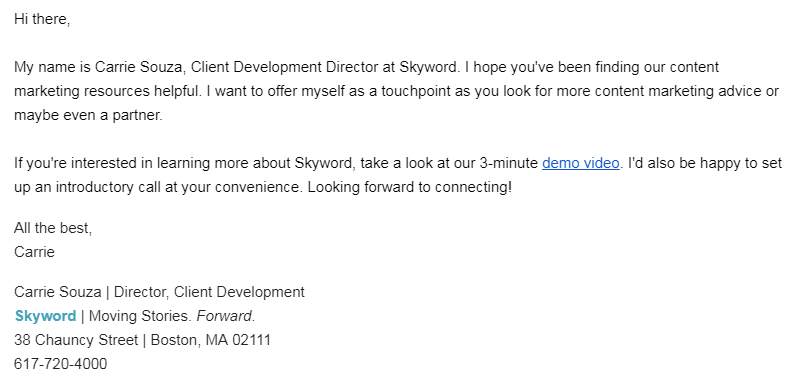 A welcome email from Skyword
A welcome email from Skyword
Explain the benefits of working with you
From time to time, you should remind your customers about some of your features and tools they can apply for their business. In case of updates or any new services, write a friendly email and explain how to use them and what benefits they bring.
MindMeister, for example, launched a new History mode feature in their app and spread the word through an email. They used colorful icons to illustrate the benefits of the History mode and provided links for those who would like to learn more about each of them.
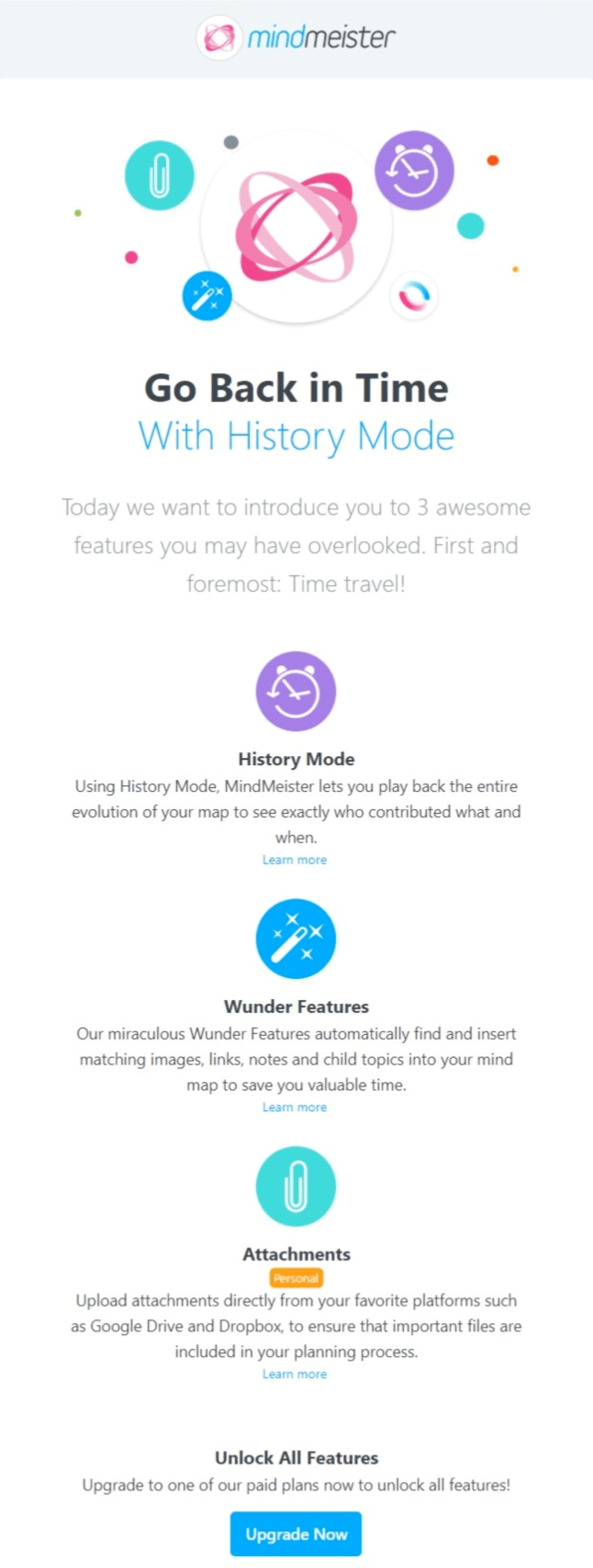 An email from MindMeister with a description of their new feature
An email from MindMeister with a description of their new feature
Demonstrate expertise
Create unique content which subscribers can use to upgrade their businesses, such as free downloadables, useful articles, videos, and other pieces.
Classy Career Girl often share PDFs and other files which users can apply at work or in their own business. Notice that CTA is repeated at the beginning and at the end of the email, and the downloadable is accompanied by a “sneak peek” screenshot of the PDF.
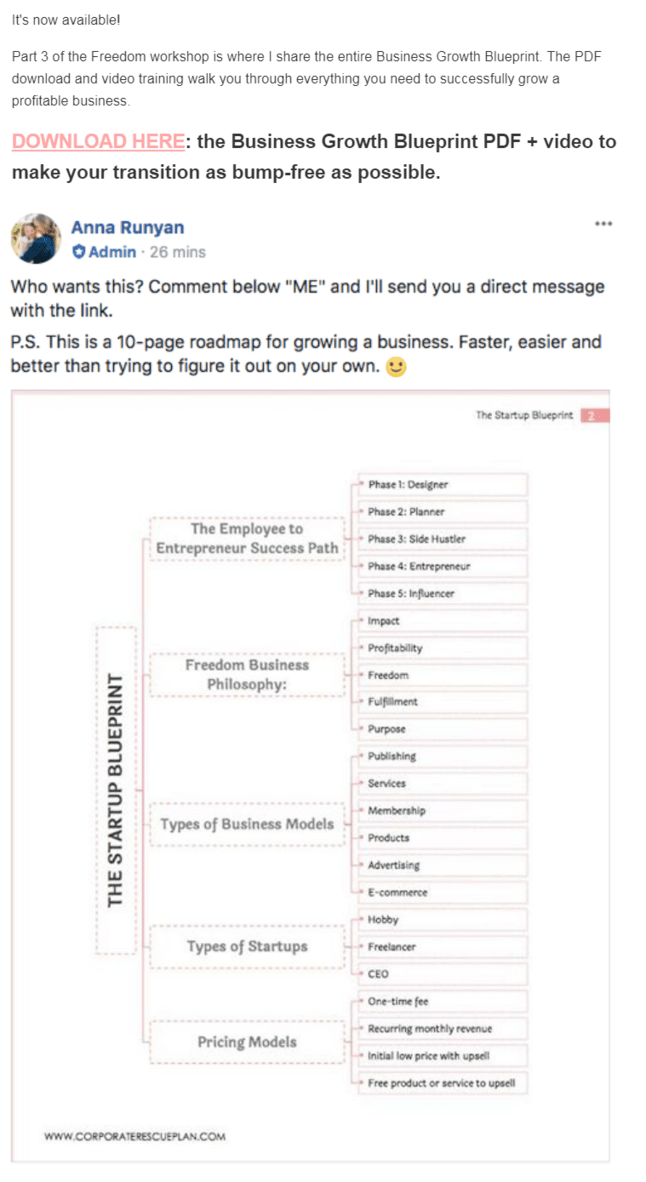 An email with a downloadable from Classy Career Girl
An email with a downloadable from Classy Career Girl
If you have a blog on your website, use emails to make it even more popular with customers. Share the latest, most popular or most commented posts from your blog, create digests, and update subscribers on the company news.
Sustainable Brands, for instance, unite links to blog articles, community updates, member news, and webinars in one email. They also use the space of their digest to offer advertisements from sponsors. You can see that they stick mostly to a double-column digest design unless there’s only one message in the section. Images and blue titles guide you through the email and help you quickly understand whether or not you are interested in the topic, while short descriptions provide more details.
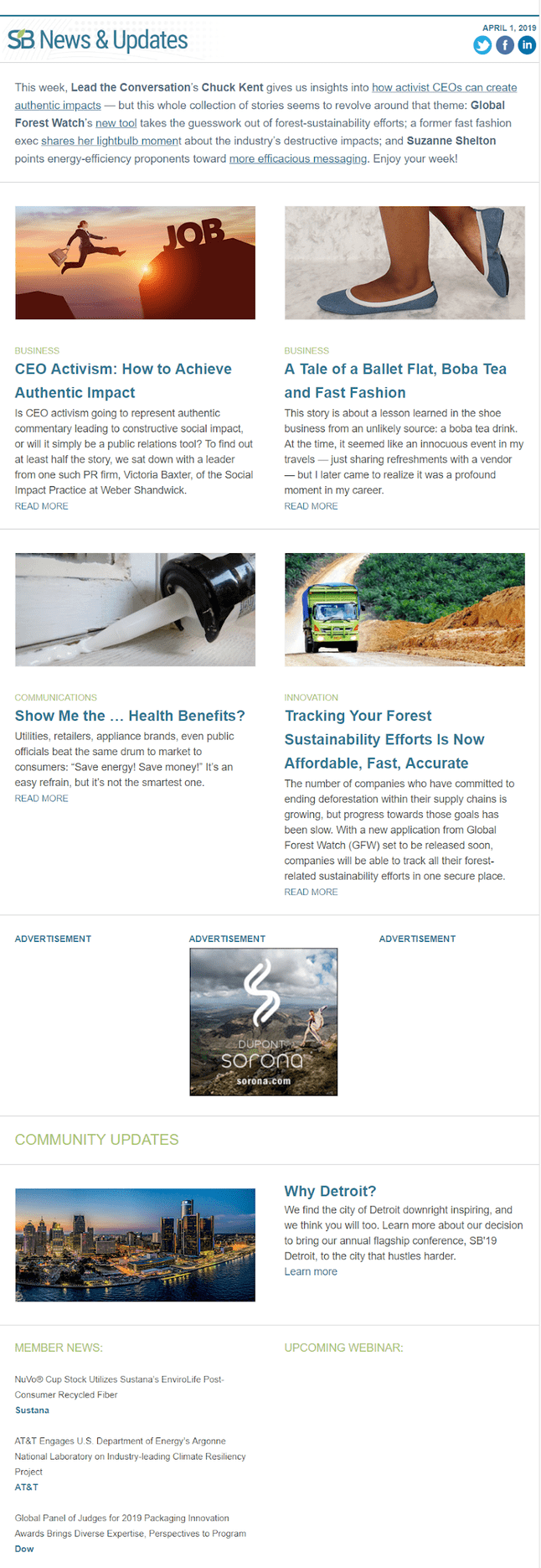 A digest from Sustainable Brands
A digest from Sustainable Brands
Promote events
Send out invitations to your online and offline activities. Mention the details — time, date, topic as well as some information about the speakers. Experiment with CTA buttons — e.g. repeat the same call-to-action several times throughout the email and see if it affects the number of event participants.
For example, Adobe invite those who “make experience their business” to Adobe Summit dedicated to digital experiences. They begin with a title in three bold and strong words “Innovative. Informative. Inspiring” which highlight the most important features and experiences you will get from visiting this event. Then, there’s a warm intro that provides all details about the event followed by a link to the preview and the tickets. The speakers, as well as the performer, are announced after the intro.
Pastel colors in the design, black and white photos and centered typography unite all parts of this email in one consistent message. The email ends with their slogan “Make experience your business.”
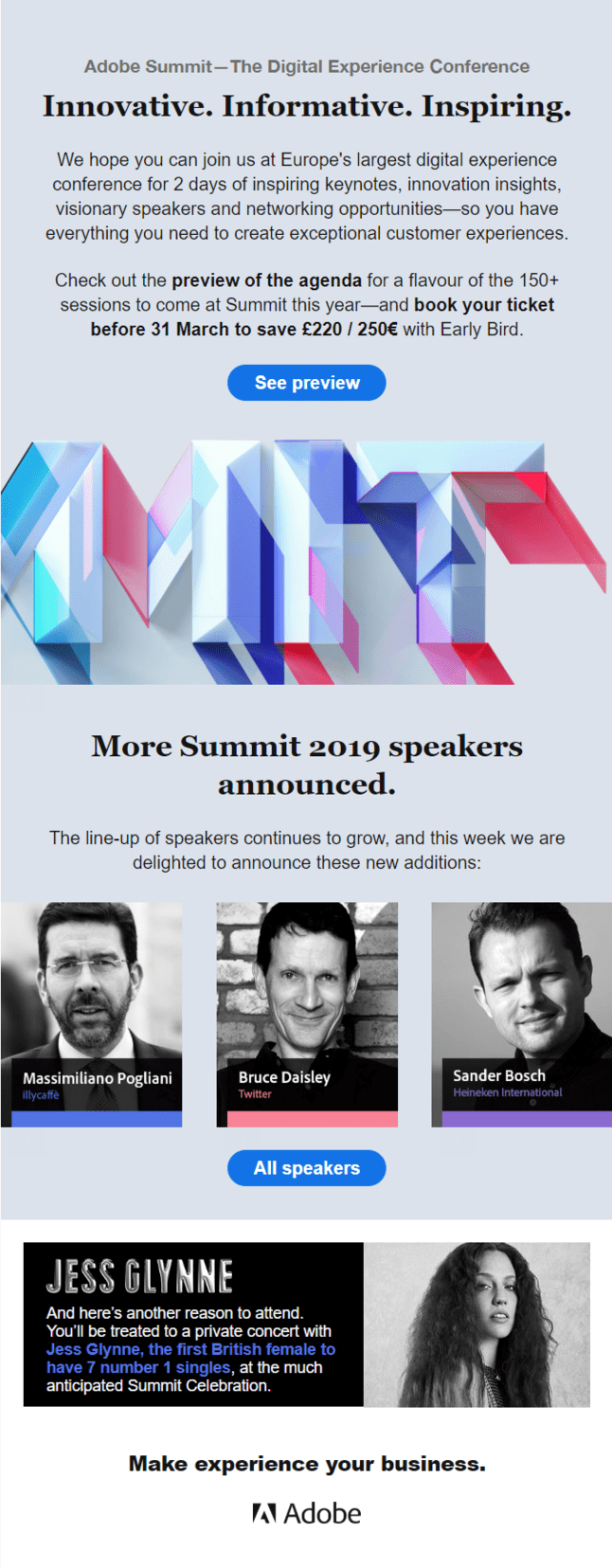 An email invitation to the Digital Experience Conference by Adobe
An email invitation to the Digital Experience Conference by Adobe
Things to remember about B2B email marketing
Email marketing is an effective solution to grow your B2B oriented business. To build strong relationships with your customers and improve sales, bring value in each email you send.
To move constantly toward your goals, follow these steps:
- Identify your B2B customer persona; understand their needs and pain points.
- Segment your mailing list according to the company’s demographics, target customers, and their previous interactions with your company.
- Set goals that can be estimated, i.e. calculated in numbers and compared to previous results.
- Build a detailed email marketing plan — timing, frequency, content of your emails — together with relevant company’s departments.
- Measure your results on a regular basis: the more often, the better. Test and improve your B2B emails.
- Draw inspiration from B2B email marketing best practices and apply these techniques to your emails.
Finally, use SendPulse to automate your B2B email marketing flows with ease.